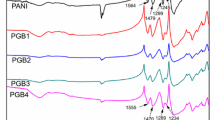Abstract
Acid corrosion and stress corrosion characteristics of E-glass fibers with and without boron (B2O3 or B) were carefully studied, using 1 N H2SO4 acid at 96 °C and room temperature, respectively. The effect of boron on glass resistance to the acid attack is elucidated in conjunction with structural roles of B, Al, and Ca in the glass. Scanning electron microscopy with energy dispersive spectrometer (SEM/EDS) characterization was performed on the selective fiber samples before and after the acid leaching. For high boron-containing fibers, the results showed the formation of alteration layer enriched in Si as a result of depletion of both Ca and Al. Chemical analysis of the high boron fibers before and after 24 h acid leaching and the solution after 24 h test further confirmed that B, Ca, and Al in the glass fibers preferentially dissolved in the acid solution. Glass fiber dissolution mechanisms were discussed with a proposal that acid corrosion attack in boron-containing E-glass is controlled by hydrolysis of aluminoborate complex species (less than 10 nm) separated from the silicate glass network, whereas the acid corrosion attack in boron-free E-glass is controlled by hydrolysis of the silicate network, where 4-coordinated aluminum in the network is locally charge compensated by Ca.












Similar content being viewed by others
References
ASTM Standard D578 (2010) Standard specification for glass fiber strands. ASTM International, West Conshohocken, PA
Wallenberg F, Watson J, Li H (2001) In: Miracle DB, Donaldson SL, Henry SD (eds) ASM handbook, vol 21, composites. ASM International, Materials Park, OH, p 27
Lowenstein KL (1993) The manufacturing technology of continuous glass fibres, 3rd edn. Elsevier, Amsterdam
Metcalfe AG, Schmitz GK (1972) Glass Technol 13:5
Caddock BD, Evans KE, Hull D (1990) J Mater Sci 25:2498. doi:10.1007/BF00638049
Caddock BD, Evans KE, Masters IG (1989) J Mater Sci 24:4100. doi:10.1007/BF01168981
Jones RL, Stewart J (2010) J Non-Cryst Solids 356:2433
Qiu Q, Kumosa M (1977) Comp Sci Technol 57:497
Kumosa L, Armentrout D, Kumosa M (2001) Comp Sci Technol 61:615
Ramachandran BE, Pai BC, Baasubamanian N (1980) J Am Ceram Soc 63:1
Spoo K (2011) Mechanism of E-glass corrosion using SEM/EDS. Paper presented at Composites & Polycon 2011. ACMA, Ft. Lauderdale, FL, 2–4 February
Romhild S, Bergman G, Comino P (2004) In; Corrosion 2004, Doc ID 04612, NACE International, New Orleans, LA, 28 March–1 April
Johns RF, Rock JW (1983) J Mater Lett 2:415
Das B, Tucker DB, Watson JC (1991) J Mater Sci 26:6606. doi:10.1007/BF00553684
Knauss KG, Bourcier WL, McKeegan KD et al (1990) Mat Res Soc Symp Proc 76:371
ISO Standard 22088-2 (2006) Plastics—determination of resistance to environment stress cracking (ESC)—part 2: constant tensile load method, 1st edn. ISO Copyright Office, Geneva. www.iso.org
ASTM Standard D3916m, 2008 (1989) Standard test method for tensile properties of pultruded glass-fiber-reinforced plastic rod. ASTM International, West Conshohocken, PA
Li H, Tomozawa M (1994) J Non-Cryst Solids 168:287
Liu X, Li L, Swango M, Li H (2012) Private communication
Kiczenski TJ, Du LS, Stebbins JF (2005) J Non-Cryst Solids 351:3571
McKeown DA, Galeener FL, Brown GE Jr (1984) J Non-Cryst Solids 68:361
Angeli F, Gaillard M, Jollivet P, Charpentier T (2007) Chem Phys Lett 440:324
Krogh-Moe J (1960) Phys Chem Glasses 1:26
Araujo RJ (1980) Phys Chem Glasses 21:193
Cormier L, Neuville DR (2004) Chem Geol 213:103
Neuville DR, Cormier L, Montouillout V, Massiot D (2007) J Non-Cryst Solids 353:180
De Jong BHWS, Schramm CM, Parziale VE (1983) Geochim Cosmochim Acta 47:1223
Engelhardt G, Nofz M, Forkel K et al (1985) Phys Chem Glasses 26:157
Prabakar S, Rao KJ, Rao CNR (1992) Eur J Solid State Inorg Chem 29:95
Bunker BC, Kirkpatrick RJ, Brow RK (1991) J Am Ceram Soc 74:1425
Bunker BC, Kirkpatrick RJ, Brow RK, Turner GL, Nelson C (1991) J Am Ceram Soc 74:1430
Zheng R, Wang SR, Nie HW, Wen TL (2004) J Power Source 128:165
Ooi K, Miyatake M (1992) J Colloid Interface Sci 148:303
Elmer TH (1984) J Am Ceram Soc 67:778
Acknowledgements
Authors thank Dr. G. Petrosyan for performing the hot acid fiber leaching tests and D. F. A. Stewart-Davis and M. Swango for performing SEM/EDS characterizations. Special thank goes to Dr. I. Giboire for her careful reading of our manuscript and suggestions to improve our work. We are grateful to PPG Fiber Glass S&T management support during the course of the investigation.
Author information
Authors and Affiliations
Corresponding author
Rights and permissions
About this article
Cite this article
Li, H., Gu, P., Watson, J. et al. Acid corrosion resistance and mechanism of E-glass fibers: boron factor. J Mater Sci 48, 3075–3087 (2013). https://doi.org/10.1007/s10853-012-7082-y
Received:
Accepted:
Published:
Issue Date:
DOI: https://doi.org/10.1007/s10853-012-7082-y




